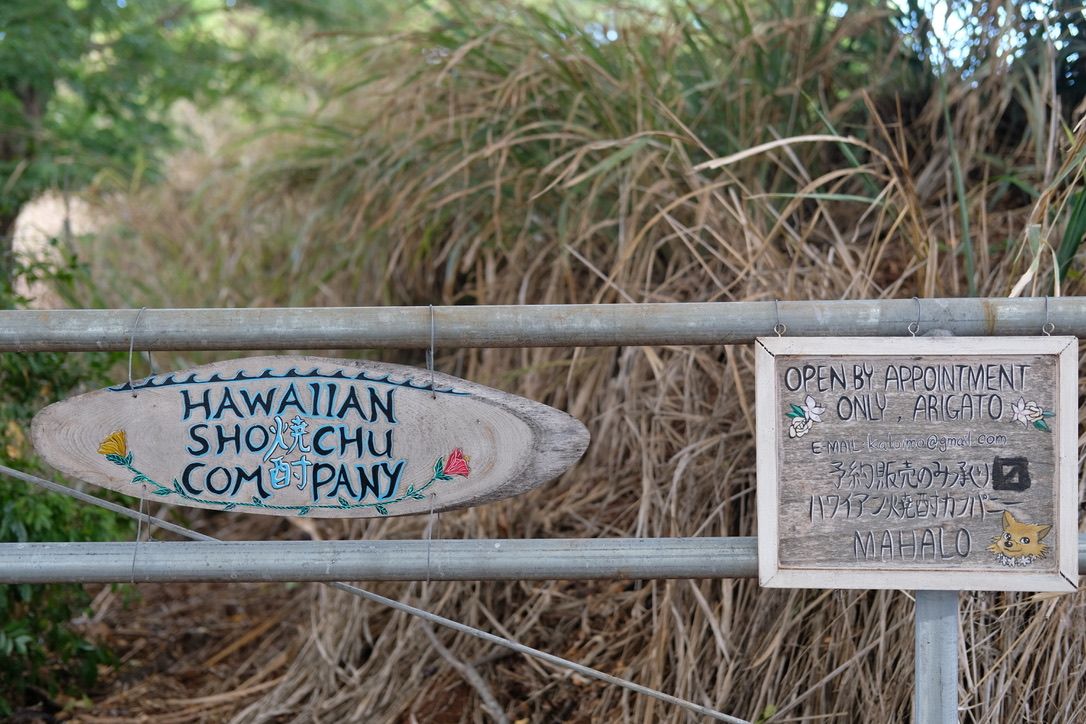Interview: Nami Hana
Ken Hirata and his wife are the proprietors behind Nami-Hana (Wave Flower) - the Hawaiian Shochu Company. We discussed his craft, his approach to Shochu making, business practices, how to prepare, lessons on entrepreneurship, perseverance, craft and more.
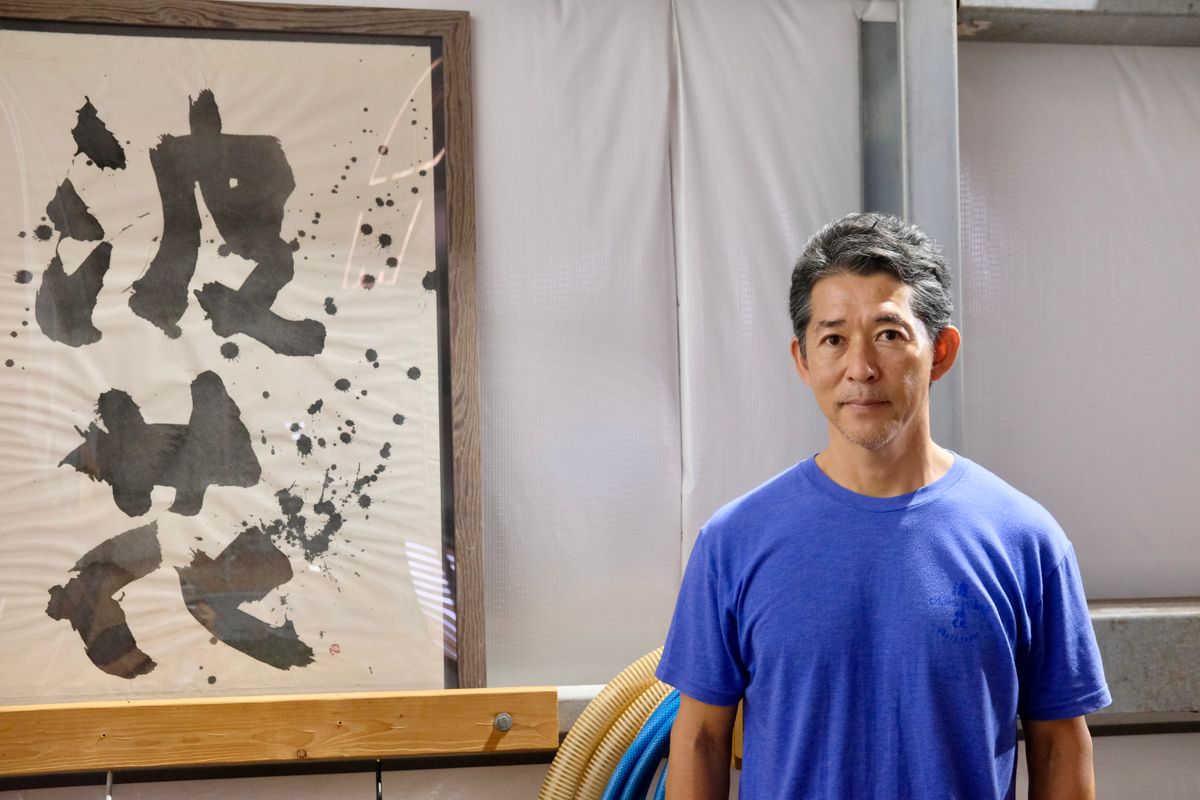
Ken Hirata and his wife are the proprietors behind Nami-Hana (Wave Flower) - the Hawaiian Shochu Company. We discussed his craft, his approach to Shochu making, business practices, how to prepare, lessons on entrepreneurship, perseverance, craft and more.
Leafbox:
Ken - Thanks so much for meeting me.
Ken-san:
Thank you for coming.
Leafbox:
So, you were saying, this business is just you and your wife, right?
Ken-san:
Yeah, this place is mainly run by myself, so it's more like a one man operation. Yeah, my wife helps, but I try not to ask her too much help. I'll be in trouble later.
Leafbox:
Do you live in Haleiwa too or no?
Ken-san:
Yeah, we live here.
Leafbox:
As well. There's a little house next door.
Ken-san:
Next door.
Leafbox:
That's so nice.
Ken-san:
Behind this wall is where we live.
Leafbox:
That's beautiful. That's great.
Ken-san:
Because once things get going, I have to monitor everything 24-7, so I have to be here.
Leafbox:
Can I ask maybe what's your background or where you're from in Japan?
Ken-san:
I'm from Osaka, Japan, I mean originally from Osaka, Japan.
Leafbox:
And did you work in spirits there as well?
Ken-san:
Because I wanted to make shochu in Hawaii, I became an apprentice.
Leafbox:
In Japan?
Ken-san:
Under my master, in Kagoshima, Japan. (Ken apprenticed with Manzen)
Ken-san:
Those two bottles over there, the black and blue, those are my senseis.
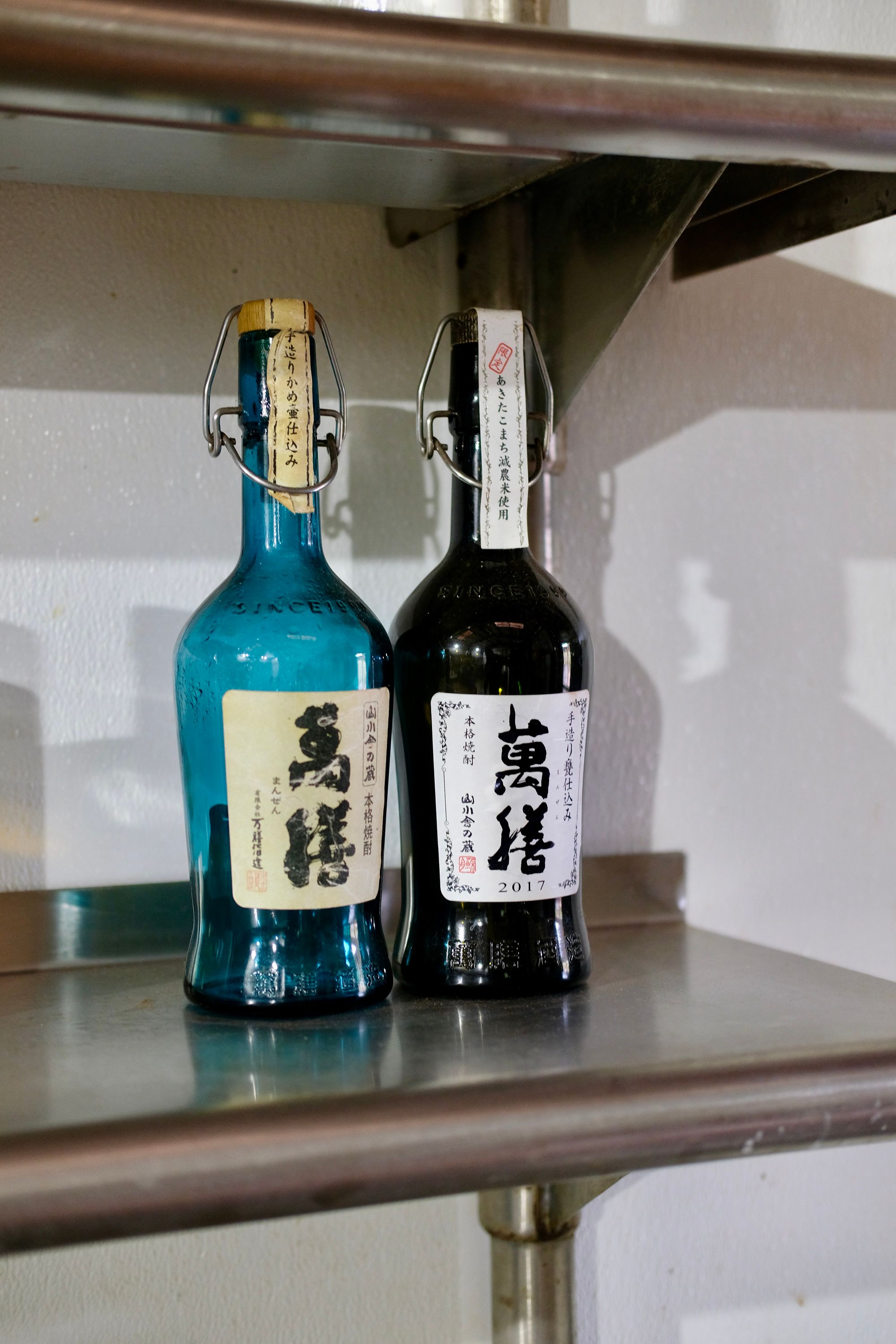
Leafbox:
And how long did you apprentice for?
Ken-san:
Only three years.
Leafbox:
What type of Shochu were they making there?
Ken-san:
Sweet potato Shochu.
Leafbox:
100% sweet potato?
Ken-san:
Yeah.
Leafbox:
Great.
Ken-san:
No, not 100% because Shochu has to be made with kōji.
Leafbox:
Yeah, well, that's the rice, the yeast, but no sugar added or barley? Because some shochu has barley.
Ken-san:
No sugar added, it's authentic shochu.
Leafbox:
Yeah.
Ken-san:
In Japan you can find a variety of Shochu. Ours is made from sweet potatoes. I think it's the most consumed Shochu in Japan. But Shochu you can be made from, as you said, barley, Mugi Shochu, rice, Kome Shochu, buckwheat, sugar cane, chestnuts, many varieties of Shochu you can find in Japan.
Leafbox:
And then you chose sweet potato because of the Hawaii varietal high sugar level?
Ken-san:
Hawaii produces a good quality of sweet potatoes.
Leafbox:
And are all your sweet potatoes from Moloka‘i or from where?
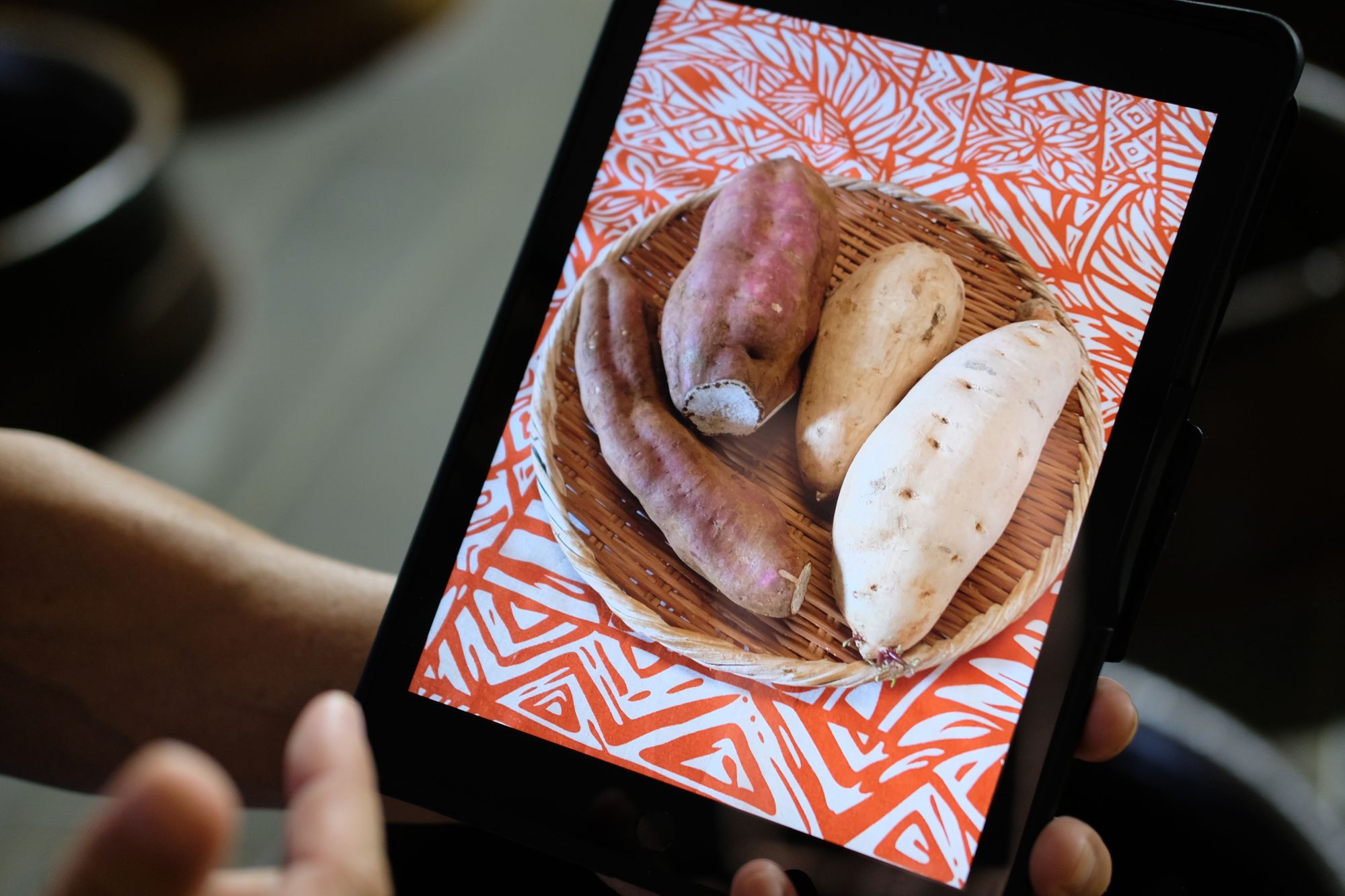
Ken-san:
Depending on the batch. So, for example, the current batch, number 19. So, this one is batch number 19. 19 means our 19th batch since we started this business, we do two batches per year. In the springtime and the fall season. For this batch, we used the sweet potatoes from Hamakua, on the big island. The previous batch, number 18, we used the sweet potatoes from Mokulēia, North shore. So, every batch is slightly different, depending on the sweet potato, the variety of the sweet potatoes we use, or the production side of the sweet potato changes.
Leafbox:
And then how do you source the sweet potato? I'm just curious.
Ken-san:
Sweet potatoes growers have been support very supportive to me, to us.
Leafbox:
Great. So, they send you a sample and then you kind of…
Ken-san:
Yeah, something like that. And they have other connections there. So, one guy introduced me to the other guy and they tried to help us. But so much super potatoes are produced in Hawaii.
Leafbox:
No, I know, so I was just curious how you select, if you're selecting for sugar level or flavor.
Ken-san:
Just a sample, and eat it.
Leafbox:
Got it. Cook it, steam it?
Ken-san:
Yeah.
Leafbox:
Nice. And then going back to Japan, what were you doing before you were an apprentice?
Ken-san:
Nothing much. I was drinking more than making.
Leafbox:
Were you a salary man?
Ken-san:
I was a, what do you call? I was working as a freelance product development type of thing.
Leafbox:
In which sector, alcohol too?
Ken-san:
No, it's more like traditional handcraft.
Leafbox:
That's cool.
Ken-san:
Yeah. But I started my career as finance, after I graduate from college.
Leafbox:
Got it. And then that was in Osaka as well?
Ken-san:
I first found a job in Hong Kong. Because I graduated from college on the mainland and then found a job in Hong Kong and moved around and ended up making Shochu in Hawaii.
Leafbox:
So, you worked in finance for a few years, in trading side or investment side?
Ken-san:
Yeah.
Leafbox:
Okay. For a Japanese securities company?
Ken-san:
It's more like international interest rate market.
Leafbox:
Got it. And then when did you become tired with the finance world?
Ken-san:
Well, as soon as I finished working in Hong Kong, I moved back to Japan, and started something else.
Leafbox:
Got it. Well, that's useful to have that finance background for the business side.
Ken-san:
I'm not that smart. So, I figured finance is not my thing. I don't have that kind of brain. Yeah.
Leafbox:
Well, I'm sure you're too humble.
Leafbox:
I'm just curious what your experience in Hong Kong was like and how did that maybe inspire anything, travel?
Ken-san:
Yeah, because I went to college on the mainland, I got to meet kids from Hawaii.
Leafbox:
You mean the United States? Not the mainland Japan.
Ken-san:
Yeah.
Leafbox:
Got it.
Ken-san:
In the US. Portland, Oregon. And many kids from Hawaii were attending the same school, so I got to meet those kids, and summer break I was able to come to Hawaii and have fun with those guys and so Hawaii became one of my favorite destinations to enjoy in summer breaks.
Leafbox:
And why did you study in the United States versus studying in Japan? I'm just curious.
Ken-san:
Just a strange thing. It just happened, yeah. Because at my place, my home, we had an exchange student from United States. So, his family invited me to their place.
Leafbox:
In Portland?
Ken-san:
In Washington.
Leafbox:
Got it.
Ken-san:
And then I ended up going to school there, I mean on the mainland.
Leafbox:
Interesting.
Ken-san:
Through the family.
Leafbox:
So, the story is getting more and more deeper.
Ken-san:
That had nothing to do with the shochu making.
Leafbox:
100%, of course it does, because if you hadn't met that exchange student, maybe you wouldn't be in Hawaii, right?
Ken-san:
No, that's true.
Leafbox:
Yeah. So, I think it's interesting to learn how... When we made beer, every single choice makes some flavor choice or selection, I think it's interesting, you know what I mean?
Ken-san:
That's exactly right, yeah.
Leafbox:
So, I was just curious what brought you to Hawaii? So, some high school college experience slowly created the dream of Hawaii, maybe in your mind?
Ken-san:
Yeah, when I was visiting Hawaii, I was eating poi with friends and then I thought maybe you can make Shochu from taro. At that time I was just joking because I didn't know anything about making Shochu from whatever. But the idea came back to me later, then I thought it would be nice to make Shochu in Hawaii. So, I became my master's apprentice.
Leafbox:
So, going back, you quit the finance, you come back to Japan, doing some freelance work. How did you select where you could apprentice? Did you just look for a specific maker?
Ken-san:
Because I really loved his Shochu.
Leafbox:
Got it.
Ken-san:
Yeah. He applied a traditional handcraft Shochu making techniques. That's kind of rare because everything has been more modernized in Japan for the mass production. But he applied a traditional way with traditional equipment. I really wanted to learn from him.
Leafbox:
And then what was your experience apprenticing like? He approved your apprenticeship to join. What was the first thing you got there? Washing pots or what was your experience? You were a brew master?
Ken-san:
No, it's not like school, so he didn't teach me how to make Shochu. He just said, okay, it took a while to get accepted because usually those type of small distilleries don't welcome the outsiders. Usually all the techniques are passed onto the next generations within family members. But it was really fortunate that he took me as an apprentice, and he said just work with me for three years, because I was already about 40 years old, usually it takes long, but he said three years, just work with me. That's it.
Leafbox:
And then you'll learn everything.
Ken-san:
Yeah. I just have to learn.
Leafbox:
Yeah. When I had the brewery, we had so many apprentice people come to just learn to make beer, whiskey, or whatever, the same, but maybe we're less difficult to say no. I think in Japan they're more harder to get in.
Ken-san:
No, it's really hard. How serious you are to learn.
Leafbox:
So, you have to keep saying, I really...
Ken-san:
I have to keep going back to him and ask or beg to accept me as an apprentice.
Leafbox:
Were you paid as an apprentice?
Ken-san:
Yeah.
Leafbox:
Really?
Ken-san:
He was really generous.
Leafbox:
Okay. That's unusual.
Ken-san:
Yeah. He is a really unique guy.
Leafbox:
And did you live in that town as well?
Ken-san:
Mm-hmm.
Leafbox:
Nice. The stereotypical image of the apprenticeship in Japan is that it's very rigorous, but maybe was this guy rigorous? Waking up, 4:00 AM.
Ken-san:
Yeah.
Leafbox:
Kind of like a dojo.
Ken-san:
Usually, just like here, work starts at 5:00 and ends at 5:00. But sometimes, often, we have to get up in the middle of the night and take care of kōji. So, same, start at 5:00 and ends at 5:00.
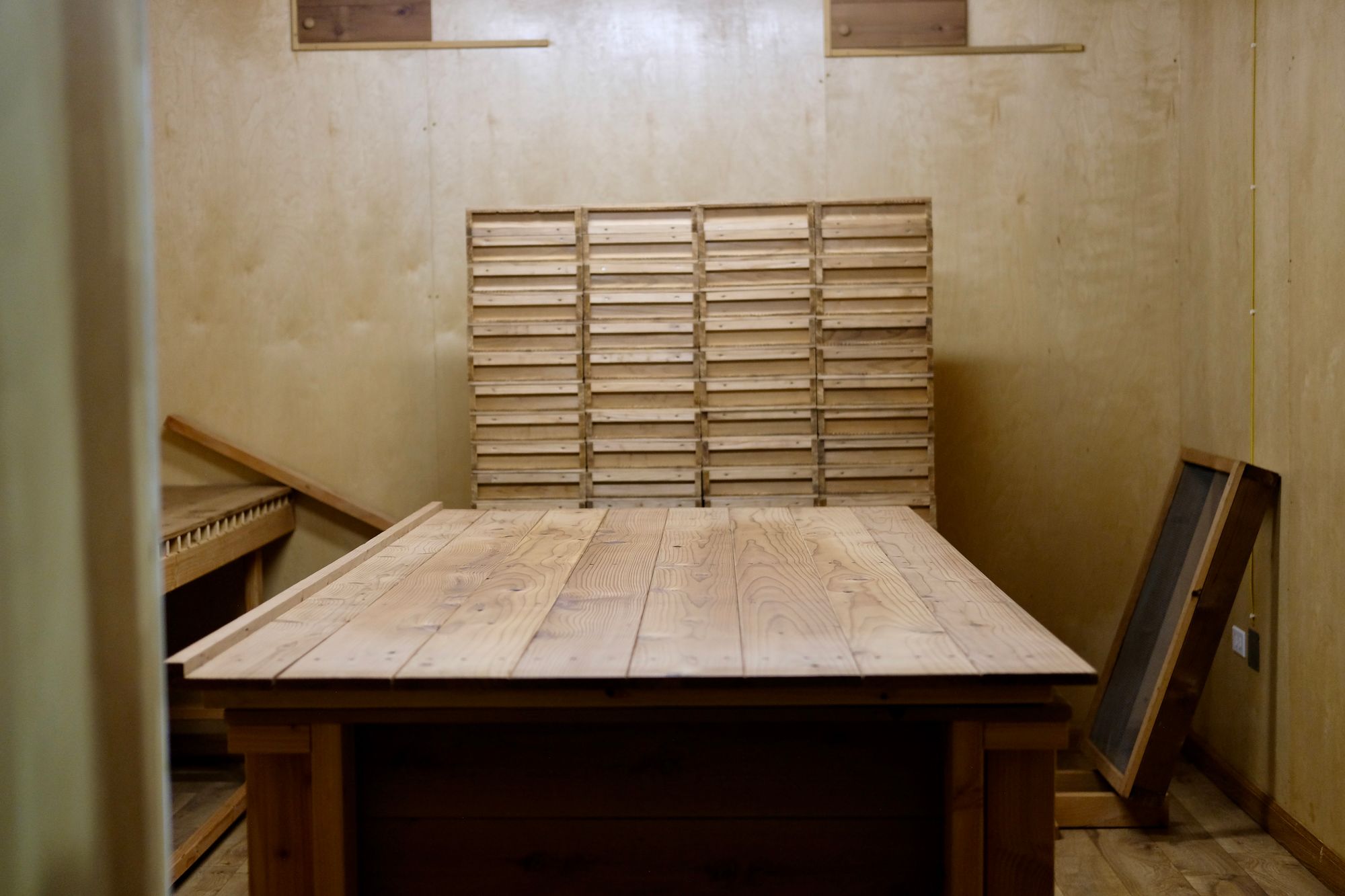
Leafbox:
And how many people, workers, did you have at this brewery?
Ken-san:
Including him, three.
Leafbox:
It's very tiny.
Ken-san:
Four, five.
Leafbox:
Lots to do.
Ken-san:
Four.
Leafbox:
And what kind of production did they have a year? Do you know?
Ken-san:
The volume?
Leafbox:
Yeah, I'm just curious.
Ken-san:
His place is considered as one of the smallest, but he makes maybe 50 times more than us. But that's one of the smallest in Japan.
Leafbox:
And it's all traditional?
Ken-san:
Mm-hmm, because he works six, eight months straight, every day.
Leafbox:
Great. So, well, let's go now to Shochu. You get to the apprentice level, did you know any of the techniques prior? You researched, read? Any familiarity with sake making?
Ken-san:
Not really. Just by reading it.
Leafbox:
Got it. No home brewing experience or anything?
Ken-san:
No.
Leafbox:
Got it. So, what were your first impressions? Just making the mash, the momodi or the...
Ken-san:
Moromi (the first fermentation)
Leafbox:
Yeah. What was your first impression? I'm just curious.
Ken-san:
I don't remember.
Leafbox:
Got it. I'm just curious.
Ken-san:
Every day was new to me. So, every day, because my goal was to establish my own distillery in Hawaii, so every single day I was trying to learn everything. Whatever I was able to learn, I wanted to learn. So, I write down everything, all the notes. So, I remember that every single thing I was doing was new to me.
Leafbox:
Great. So, maybe, Ken, you can walk us through what's the basic process for making Shochu?
Ken-san:
Shochu, same as sake, the first step of Shochu making or sake making is kōji making. Kōji can be made with rice, barley, sweet potatoes, buckwheat, whatever you want. Just because we make sweet potato Shochu, that doesn't mean we have to use sweet potatoes to let the kōji mold grow on. So, the mother can be anything, it can be rice, whatever. So, in our case we make sweet potato Shochu you but our kōji is kōji rice. So, we let the kōji mold grow onto rice. So, that's the first step, we convert the rice into kōji rice. That's the first step.
Leafbox:
And are you using a starter or where do you get the initial strain of kōji?
Ken-san:
We buy a starter from the kōji makers from Japan. There are kōji makers, because miso makers, Shoyu makers, sake makers, Shochu makers, they all need kōji. So, there are kōji makers in Japan
Leafbox:
Yeah. They grow the yeast, yeah.
Ken-san:
And they supply the starters to those people who need kōji. So, we buy the starter from the kōji makers.
Leafbox:
Why are you using rice for the base instead of-
Ken-san:
It's just a personal thing. You can use whatever you like.
Leafbox:
And what kind of rice are you using?
Ken-san:
We use rice from California. Yeah, Koda Farms. I have a picture.
Leafbox:
Yeah, I know Koda Farms in Northern California. Yeah.
Ken-san:
Yeah. We import the Koda Farms heirloom rice, the highest quality rice they produce.
Leafbox:
Did you experiment with different rices?
Ken-san:
Yeah, we tried to source ingredients as local as possible, but no rice in Hawaii. The closest we were able to find was California rice, and we picked some, and I got Koda Farms.
Leafbox:
Have you ever looked, is anyone making wild yeast kōji? Because some beer people or natural wines, they use natural yeast.
Ken-san:
Kōji cannot...
Leafbox:
There's no way to reproduce?
Ken-san:
No.
Leafbox:
Just wild growth?
Ken-san:
No, because it's just a mold and it's easily get contaminated. You cannot use wild kōji. It might be a bad mold.
Leafbox:
Yeah, and then the flavors will go bad. Yeah.
Ken-san:
So, you usually we use the kōji from kōji makers.
Leafbox:
So, in traditional Japan do they have the kōji makers as well?
Ken-san:
They have over a thousand years of history.
Leafbox:
Really?
Ken-san:
Yeah. So, they have been supplying the starters to all the people who need kōji.
Leafbox:
And their own technique is just kōji making.
Ken-san:
Yeah.
Leafbox:
That's interesting. My family business is, do you know what rennet is? Rennet.
Ken-san:
I'm sorry, I don't know.
Leafbox:
Rennet is to make cheese.
Ken-san:
Cheese.
Leafbox:
It's the fungus to make different types of cheese. So, there's many types of rennet that you can make from the stomach of the cow, you can cultivate that and grow the yeast.
Ken-san:
Interesting.
Leafbox:
But my family has a factory that we make yeast, but for cheese making.
Ken-san:
Yeah, similar.
Leafbox:
Similar. But we actually have to buy a starter from Japan.
Ken-san:
Us?
Leafbox:
No, my family business. Yeah, we've been buying for over 70 years from the Meiji Company, the confectionary company.
Ken-san:
Yeah, Meiji, yeah.
Leafbox:
They have an industrial biochemical food... Yeah, so my grandpa started that business and he's been buying the same... So, I understand, people are very specialized in making... Meiji's a big company obviously, but, yeah.
Ken-san:
Because, as you know, kōji mold, you can find it in nature. Isolating the pure kōji strain is a hard thing to do.
Leafbox:
Yeah. You have to know how to maintain the starter, it's like growing a mushroom.
Ken-san:
Yeah. So, we just buy from the kōji makers.
Leafbox:
Yeah. The same when I had the brewery, we would use different strains of yeast, some from Germany, some from the US, some from Amsterdam.
Ken-san:
It's similar.
Leafbox:
Yeah, the same. But you could take the purge and then regrow it sometimes.
Ken-san:
That's something we cannot do with kōji.
Leafbox:
With Shochu. Yeah.
Ken-san:
Yeah.
Leafbox:
Interesting.
Ken-san:
We use both kōji and yeast.
Leafbox:
What kind of yeast are you using?
Ken-san:
We use different types of east depending on the batch. But sometimes we use the yeast from Hawaii, which is isolated from some plants, cacao and stuff. Sometimes we use yeast from Japan. It depends.
Leafbox:
And these are dry or wet?
Ken-san:
Wet.
Leafbox:
And then obviously temperature management becomes...
Ken-san:
I don't do it. I ask a lab to produce a yeast culture.
Leafbox:
Got it. Yeah. Because, like you said, it can become volatile and other things grow.
Ken-san:
You can use wild yeast, but Hawaii, the temperature is warm, so contamination is the worst thing. So, I try not to use the wild yeast without using the yeast culture.
Leafbox:
Yeah. It's very interesting. You know ava, right? Kava? They sometimes ferment, but I think they're using wild yeast, they just let it outside. So, or a pineapple has some yeast on the side. You can use that.
Ken-san:
That's right.
Leafbox:
Like a tepache, making a Mexican low alcohol, but you're not going to get the alcohol you need.
Ken-san:
That's true. Yeah.
Leafbox:
The levels you need.
Ken-san:
It's too warm now.
Leafbox:
Yeah, probably. But so, kōji making, fermenting the rice, what's the process with getting the kōji growing for you? Or how long does it take?
Ken-san:
48 hours. After I've seen the rice, I take the rice into this small room called the kōji room, you want to see?
Leafbox:
Maybe after we can look, yeah.
Ken-san:
Okay. And I come in here and do all kinds of stuff every three, four hours, for 48 hours. After 48 hours, the rice becomes culture rice, which we call kōji rice. That's the stage, kōji is a mold, it grows onto or into rice nicely and evenly. So, kōji rice is a molded race, that takes 48 hours.
Leafbox:
And then the next step after that?
Ken-san:
We ferment the kōji rice first. Then we do two stages of stages of fermentation. First we ferment the kōji rice with yeast and water, then add the main ingredients and ferment again. So, we do two stages of fermentation.
Leafbox:
And what's the time, how long does the first run take?
Ken-san:
One one week for the first stage, and second stage, about eight to 10 days.
Leafbox:
So, it's relatively fast. And this is without temperature control?
Ken-san:
Hawaii is relatively mild, so for Shochu we ferment around 30 to 32 degrees Celsius, so usually we don't need to control much. But I do, I monitor the temperature really carefully, but we don't have to have a machine or anything.
Leafbox:
You don't have any jacketing?
Ken-san:
No, nothing. We only have those, do you see those coils?
Leafbox:
Correct, yeah.
Ken-san:
We just keep the coil inside.
Leafbox:
To cool the temperature, yeah.
Ken-san:
When it gets too warm.
Leafbox:
And then that's usually, maybe on the fourth or fifth day, the temperature is going to go up, depending on the weather.
Ken-san:
First few days, yeah. But I try not to do much. I try not to do as much as possible.
Leafbox:
What's your mash process? How do you prepare the sweet potato?
Ken-san:
I just steam.
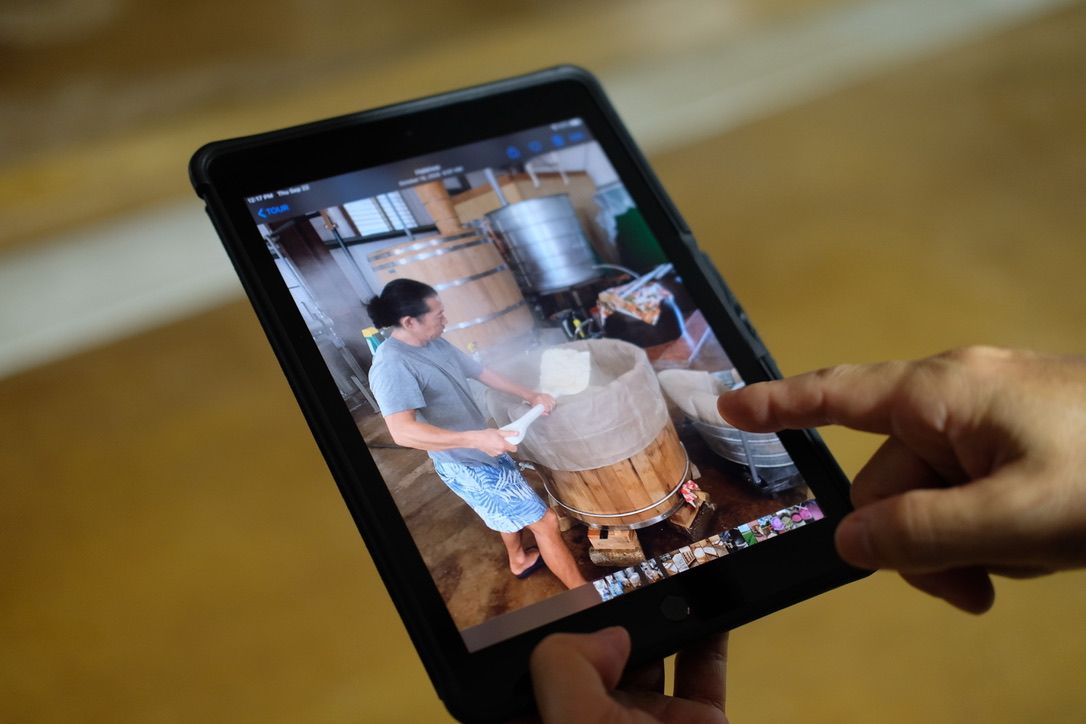
Leafbox:
So, with skin or no skin?
Ken-san:
With skin on. I try to leave the skin or as much as possible too.
Leafbox:
Interesting. And then you put all that in, and?
Ken-san:
And mix with the kōji rice.
Leafbox:
And that's enough sugar content?
Ken-san:
Yeah.
Leafbox:
And then what's your alcohol level you're getting to in the first…
Ken-san:
About 15% after the second mash is fully fermented.
Leafbox:
And you filter out and then...
Ken-san:
More filter.
Leafbox:
How do you distill then?
Ken-san:
We just put the whole thing into the still and distill.
Leafbox:
Got it. And how fast is your distillation?
Ken-san:
Three hours.
Leafbox:
Okay. And then you have impurities taken out. Do you have to take out the front or the tails at all or no?
Ken-san:
No, we just take the tail off.
Leafbox:
Because the flavors become too strong?
Ken-san:
Yeah, I don't like to, it's up to the distiller. So, we collect our shochu at 40%, 80 proof. That's it.
Leafbox:
And then do you do cask aging or anything?
Ken-san:
Usually Shochu don't age in a cask, that's a good thing about shochu. You don't have to age in a cask. You can still enjoy without aging. So, I repeat the process over and over to fill up the green tank, do you see?
Leafbox:
Yeah.
Ken-san:
And let it mature another four, five months, then bottle. So, it takes six months to do one batch, and one tankful produces about 3,000 bottles.
Leafbox:
So, say that again one more time, so why does it take so long to put into the green tun?
Ken-san:
After we ferment our mash in those vats, and we distill with the wooden pot still. And I have to repeat this process over and over to fill up the green tank.
Leafbox:
Got it. Perfect.
Ken-san:
Yeah, that takes about two months, and we use about 12,000 to 15,000 pounds of sweet potatoes.
Leafbox:
So, the main concern here is the lack of the primary mash ton size. If you had twice the size, you could fill it faster obviously. Yeah.
Ken-san:
Yeah. But we have enough or you repeat more as much as you want.
Leafbox:
Well, you still have to sit it there for two weeks, right?
Ken-san:
One week, and another eight to 10 days for second mash.
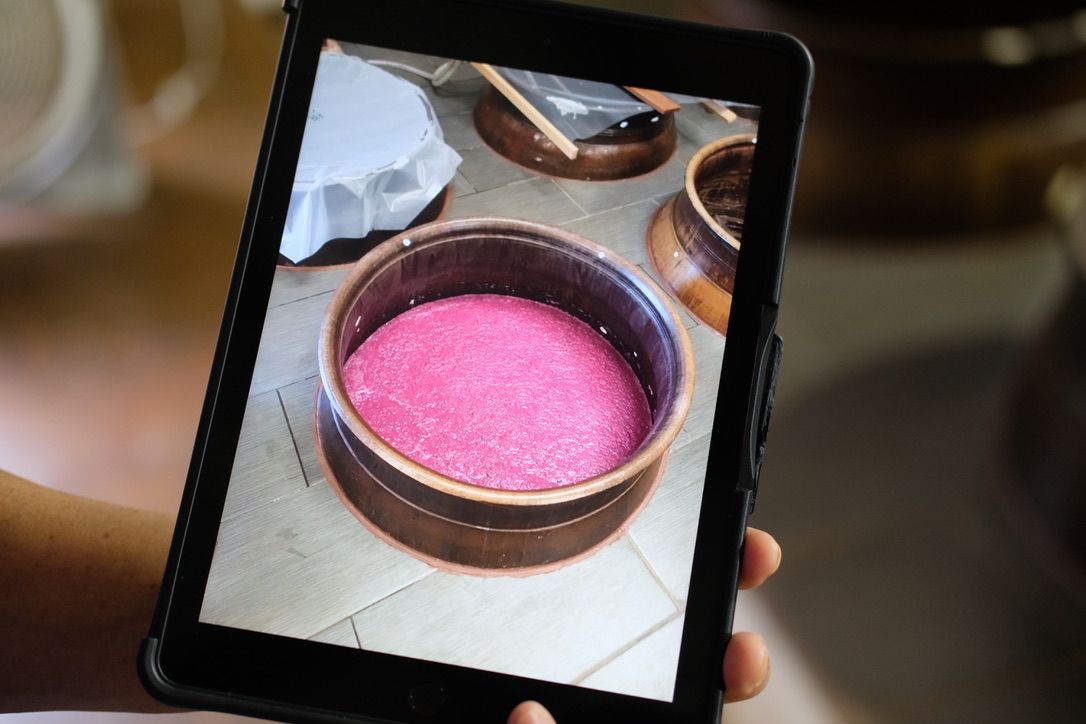
Leafbox:
Yeah, much faster. Plus, you don't have to age, which is nice for the...
Ken-san:
Yeah, one good thing about Shochu is people enjoy the aroma, so if you age too long, it becomes smoother like other spirits, but it loses the aroma.
Leafbox:
Is anyone aging shochu in Japan?
Ken-san:
Yeah, many people do. So, we do sometimes, we have barrels. We sometimes age our Shochu in the barrels and make it do that, but if you age in the wood, it becomes more like a whiskey. So, I try not to age too long, so that loses that characteristic
Leafbox:
The Shochu?
Ken-san:
The shochu.
Leafbox:
Is that considered a new technique? The casking? Even in Japan, they've been...
Ken-san:
Yeah, especially the mugi guys, mugi is the barley shochu guys, sometimes they age in a barrel.
Leafbox:
So, they're trying to make more a whiskey flavor?
Ken-san:
More like it. Yeah.
Leafbox:
Interesting. Is that because of Western influence?
Ken-san:
I think so, because people have been drinking whiskey long in Japan. But the barley shochu guys don't age as long and as dark as whiskey guys. It's very light. So, the color is really light.
Leafbox:
And they're probably reusing the... Well, because the issue with whiskey, it just becomes so expensive.
Ken-san:
The barrels?
Leafbox:
Well, the warehousing costs.
Ken-san:
Yeah.
Leafbox:
If you have 10 years or five years. So, you're making six months, 3,000, the economics are a little smoother.
Ken-san:
Right. And then I think tax category changes in Japan under the liquor law. As long as it's shochu, I think tax is lower. If it gets darker, it's categorize as whiskey, so you have to pay higher tax I think before. I'm not sure right now.
Leafbox:
I had a question about how do you find the permitting process in the US for liquor production?
Ken-san:
I just have to ask.
Leafbox:
I know, but are you happy with it? Because many people find the TTB and the licensing very complicated.
Ken-san:
Yeah, very complicated. Yeah.
Leafbox:
So, you just went through a ganbaru, you just did it?
Ken-san:
Yeah, because I didn't know anybody.
Leafbox:
Got it.
Ken-san:
So, I just did just all the paperwork.
Leafbox:
Did you have any people, or when you called them, they didn't understand why you were making Shochu?
Ken-san:
Yeah, because Shochu was not established. I mean, it's still not. So, that was tough. But Hawaii people have been really nice and supportive and they're really kind to me. So, as long as Hawaii is considered, it was okay. But the federal side was kind of tough.
Leafbox:
Yeah, they have very complicated... The TTB.
Ken-san:
Yeah, no local office here.
Leafbox:
No, I understand, because when we had to do our brewery, it was bottling rules, everything is so complicated.
Ken-san:
I still don't understand.
Leafbox:
The labeling, well, you have to hire a lawyer and then they help you.
Ken-san:
We didn't have money to hire a lawyer so I just had to... But they were helpful.
Leafbox:
Yeah, they want you to open, it's just sometimes...
Ken-san:
So, I had to get the approval of labels and everything.
Leafbox:
Yeah, well, once you learn, it's not so hard, but, interesting. You're like a pioneer.
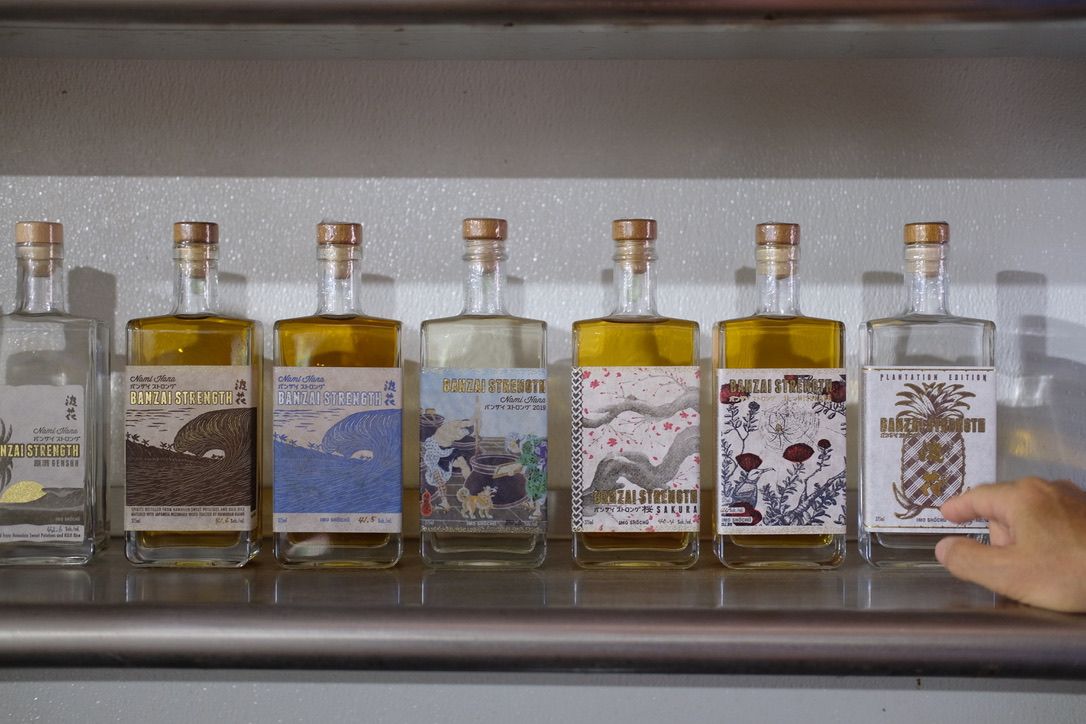
Ken-san:
Not really, I just had to do it.
Leafbox:
Do it. So, I'm just curious, how do you find the business climate in Hawaii? Is it positive then?
Ken-san:
To us, yeah, Hawaii people have been really, again, supportive for this type of small businesses. I know that cost wise it's high compared to Japan or maybe mainland, I don't know. But the people have been really nice.
Leafbox:
Any challenges that you wish you had known about earlier when you opened? How many years have you had the...
Ken-san:
This is the 10th year.
Leafbox:!
10th year. Nice. Congrats.
Ken-san:
Arigato. Yeah, everything was a challenge in the beginning because I didn't know anything about Shochu. So, it's okay, because I just didn't know anything, so it was natural that everything became challenges.
Leafbox:
And why didn't you want to start maybe the brewery in Japan? Did you find…
Ken-san:
Well, I had no interest in making Shochu in Japan. I just wanted to make Shochu in Hawaii.
Leafbox:
Got it.
Ken-san:
So, that was the first objective or goal.
Leafbox:
Do you think because of the local market need or just the sweet potatoes or you wanted to live here?
Ken-san:
All the combinations there. I thought Hawaii would be a great place to make sweet potato shochu, because we can source the local sweet potatoes and the water quality is pretty good, the climate, perfect for shochu making. Yeah. And living in Hawaii, making shochu, would be nice.
Leafbox:
Nice. Is anyone making herbal additions to Shochus or anything like that?
Ken-san:
Herbal addition?
Leafbox:
Like amaros, once you take your high proof, so once you distill, you're adding water to dilute the-
Ken-san:
Dilute to 30%. For regular, yeah.
Leafbox:
Yeah.
Ken-san:
This is more like a cask strength. So, it's a still strength.
Leafbox:
But you know amaros, like a Campari, they add herbal...
Ken-san:
We made gin.
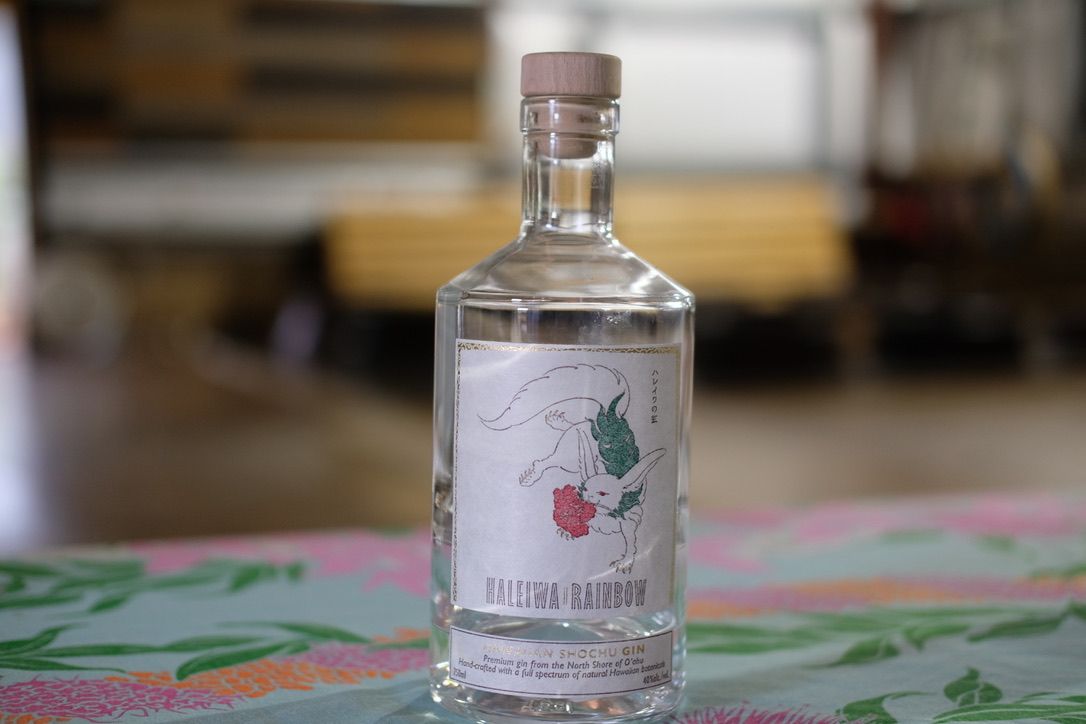
Leafbox:
So, you've done with juniper and things?
Ken-san:
Juniper and Hawaii grown botanicals.
Leafbox:
Great. Does your license allow you to make that?
Ken-san:
I think so.
Leafbox:
Well, you have a distiller's license.
Ken-san:
Yeah. So, I thought it was okay. So, this is something we made last year.
Leafbox:
This is beautiful. Look at the bottle.
Ken-san:
Because one of our customers happened to be the owner of a distilling equipment company in Canada. He came six, seven years ago, and he offered us this piece of equipment. So, he ship it to us last year.
Leafbox:
And with that you could make the gin.
Ken-san:
And then at the same time we had a guest from Kyoto, he's the owner of Kyoto Distillery, first gin distillery in Japan. He came and he invited me to his place in Kyoto. So, I went there four or five years ago and I learned the gin making process. So, I thought, well, it would be good to make gin one day. And this came and I thought, oh, let's make gin. Because I enjoy making and drinking gin.
Leafbox:
Nice. And then where did you get the juniper from?
Ken-san:
The juniper was imported from Italy, but other botanicals, mainly we use Hawaii grown ones.
Leafbox:
Interesting. I'll have to read that, yeah. Because I've been making some amaros at home.
Ken-san:
What is that?
Leafbox:
Amaro, it's a category of a digestif.
Ken-san:
Campari?
Leafbox:
Campari is an amaro. Fernet is an amaro. There's hundreds of amaros, amaro, nonino.
Leafbox:
Amaro is a category. It's like a digestif or aperitif.
Ken-san:
Is that like a liqueur?
Leafbox:
It's a liqueur, it's not like champagne that comes from one place, amaro could be Bonal, there's many, hundreds. So, all you do is take a high liquor, high proof spirit, usually they make that and then they add different medical herbs.
Ken-san:
Just like gin?
Leafbox:
Yeah, but the flavor is very... Amaro stands for bitter. So, gins can be bitter also, but it's interesting, usually they have a red color because some of the herbal ingredients you get.
Ken-san:
Like Campari, yeah.
Leafbox:
Yeah, Campari obviously, that uses the shell or seeds to get that color. So, you age it and, same, you can cask it. Anyway, I like amaros a lot, they're very popular in cocktails like a Manhattan or vermouths kind of thing. So, I was just curious if anyone is making that with shochu, if you take your 80 proof...
Ken-san:
Yeah, 80 proof is low though.
Leafbox:
I know, you need 100 to really get the flavors out. So, I was curious of what they're doing in Japan. Because I know in Japan there's a few amaro makers now.
Ken-san:
I think Kyoto Distilleries, this Kyoto Distillery, they make gin, but just like many Gin makers, they outsource the alcohol. They can buy alcohol made from rice. The proofing is really high.
Leafbox:
Then they can add the sugar and the flavors and the water. So, it's interesting, then the branding.
Ken-san:
So, probably those guys outsource, they buy higher proof alcohol made from rice. It's widely available in Japan, so they can make amaros or whatever.
Leafbox:
Any digestif or liqueurs or whatever. Interesting. Anyway, sorry, interesting. I was just curious what herbs that people can add. Yeah, very fascinating. And then are you happy with the business or do you have growth plans, or export? I'm just curious, what's the next 10 years for the business?
Ken-san:
Next 10 years, I just want to maybe increase the production just a little bit, but not double the size or anything, we just want to keep it pretty close to as it is and enjoy the life.
Leafbox:
Have you had any apprentices?
Ken-san:
No, I'm not a master.
Leafbox:
But no one's come to...
Ken-san:
People contact me, but many of them are not really serious, because many say, "I'm going to Hawaii for vacation for two weeks, can I learn Shochu making?" I don't take it as serious.
Leafbox:
No, unless the guy lives here and moves one year at least, yeah.
Ken-san:
So, it's hard.
Leafbox:
Do you ever hire workers to help you?
Ken-san:
No. I have some people who are on the payroll, my friends, they help me in bottling or filling when we're really busy.
Leafbox:
Packaging.
Ken-san:
Yeah. Packaging, my wife and I.
Leafbox:
Nice.
Ken-san:
Basically just me. Yeah, when we're busy doing our really big stuff, friends come, that's it.
Leafbox:
And then your distribution is 100% only sold here, right?
Ken-san:
20% goes to the distributor, and they distribute to the restaurants and businesses, like restaurants, hotels, bars, in Hawaii. 80% is sold right here, I'm the salesperson.
Leafbox:
And then how did you select your distributor? They came to you?
Ken-san:
Yeah, I think we had a connection, my master had a connection. So, they distribute it to the restaurants in Hawaii. No retail stores.
Leafbox:
Yeah. Well, that can introduce licensing issues with the...
Ken-san:
No, just the volume side, our volume is so small it's hard for us to sell to a wholesaler.
Leafbox:
Yeah, plus your margin would be much higher.
Ken-san:
Yeah, if we sell more to the wholesale, we go into the red due to the volume.
Leafbox:
And then looking back on the last 10 years, are there any things you wish you had known? I'm just curious.
Ken-san:
Everything, yeah. I wish I had known everything.
Leafbox:
Specifically?
Ken-san:
I don't know, I wish that I'd known that COVID was coming.
Leafbox:
Yeah, well, how has COVID affected your business?
Ken-san:
It's changed our plan, yeah, because we lost our orders from the businesses, and many orders from international customers, especially from the Asian countries, mostly from Japan. So, maybe 40% we lost. But people have been really supportive here, so it ended up okay.
Leafbox:
Did you get support from PPE loans or anything?
Ken-san:
Yeah, we did, yeah, that helped us a lot.
Leafbox:
Was there any positive things from COVID, business wise or experience?
Ken-san:
Yeah, always, yeah. People, after you go through hardship, you learn something.
Leafbox:
What did you learn? Anything?
Ken-san:
That's a good question. I hope I learned something.
Leafbox:
Still thinking about it.
Ken-san:
Yeah. I hope I did learn something.
Leafbox:
Are there any new processes you're learning now that you want to?
Ken-san:
Yeah, every day is still a challenge, I'm not a master guy, so every single stage, I put so much thoughts into... Even just this is my new thing, I experiment something new.
Leafbox:
How do you maintain that beginner's mindset?
Ken-san:
Because I still feel I'm a beginner.
Leafbox:
I think that's a cultural difference because sometimes maybe the Western perspective is after a few years they think they're the expert. So, I'm just curious.
Ken-san:
I wish I could say that, but, no, it's not really simple. It looks simple but every single thing, every single stage is different. Yeah.
Leafbox:
In the brewing community there's online forums. Many of the beer people talk to each other a lot, share tips, share ideas, is that happening in the Shochu world or is everyone secret?
Ken-san:
If you are in Japan, yeah, those Shochu makers, sake makers, they help each other, have a workshop and stuff. But I'm so isolated here, so not much, I just talk to my master.
Leafbox:
Got it.
Ken-san:
Yeah, and master's sons.
Leafbox:
And have they been here to visit?
Ken-san:
Yeah, they use me as an excuse to come to Hawaii every year.
Leafbox:
Nice.
Ken-san:
So, I get to see them. Whenever I go to Japan, I go to seem them too in Kagoshima.
Leafbox:
Interesting, cool. No, I have many questions to ask.
Ken-san:
That helps.
Leafbox:
Yeah, I think it's interesting to learn about who the person is making the spirit, because I think if you're a small business, it's...
Ken-san:
It's a very tiny distillery.
Leafbox:
Yeah, but that feels like an honest product, right?
Ken-san:
Every single thing, everything we bottle, it goes through me, so, yeah.
Leafbox:
So, what's the best way to drink your Shochu?
Ken-san:
Usually shochu, we sip while we eat, the authentic shochu, during the meal. So, we tend to make it lighter by adding lots of ice, on the rocks, or something ice water, or even hot water in the traditional way. So, you can enjoy different ways. Some people make cocktails, but usually I sip with the food, during the dinner.
Leafbox:
Nice. And then since you live in Hawaii, what other parts of Hawaiian life do you participate in? Surfing or hunting?
Ken-san:
I surf but I'm not that good, I'm not bad, I'm not good. Especially the North shore, those guys are really good, so I get depressed every time I go surfing, because the guys are really good.
Leafbox:
Yeah, but it's okay, it's just for fun.
Ken-san:
Yeah, it's okay. But it's just like, I'm so jealous of it.
Leafbox:
Do you hunt at all?
Ken-san:
No.
Leafbox:
Gardening?
Ken-san:
No, not much.
Leafbox:
And then your family relationship, no children?
Ken-san:
No children, only adult.
Leafbox:
Great. And what was your wife's reaction when she first heard your plan?
Ken-san:
Nothing much, she said, "That will be fun," that's it, "Let's go."
Leafbox:
Great, lucky guy.
Ken-san:
Lucky me, yeah. She's been really supportive.
Leafbox:
Do you think maybe most Japanese people take the safer route of a salary man? How do you explain your deviation or willingness to start a business? Where does that come from, was your family...
Ken-san:
Yeah, my father owned a company too, so I was not born in a salary man's family. He had his own business.
Leafbox:
Got it, so you had that experience doing that.
Ken-san:
Yeah, so I never thought starting a business is a challenge or something. It's a fun thing.
Leafbox:
And maybe last question, if someone was to start a business, what's your number one advice?
Ken-san:
Prepare well.
Leafbox:
And how do you prepare well?
Ken-san:
Prepare better. Yeah. Preparation is the most key thing if you want to start a business. Of course, Shochu making, prepare, prepare, prepare.
Leafbox:
And then how do you know when you're ready to jump?
Ken-san:
You still prepare while you're jumping, yeah. Do you know what I'm saying?
Leafbox:
Yeah, it's like a parachute, you build the parachute as you're jumping off the plane.
Ken-san:
Not like a safety device, but you have to think about all the options and just prepare, you just have to clean and get ready in case something happens, so your mind is always, if something really bad happens, you don't get really too anxious or something. I don't know.
Leafbox:
And how did you choose this location on the North shore?
Ken-san:
We were really lucky. We looked for all the islands, but hard to find, but one of our friends who knew the landowner, and they offered us this piece of land. So, we lease from Kamehameha Schools.
Leafbox:
Really? This is Kamehameha Lands?
Ken-san:
Yeah.
Leafbox:
Nice.
Ken-san:
And they have been really nice.
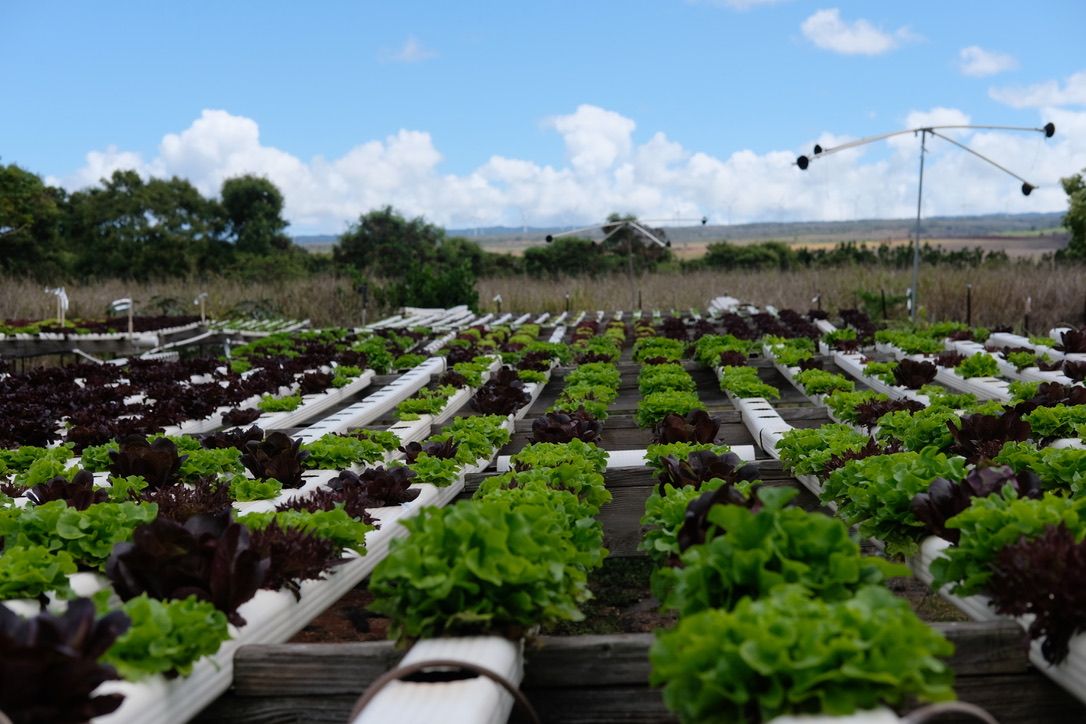
Leafbox:
And then did you build the bodega or the warehouse?
Ken-san:
Yeah, we built this.
Leafbox:
Great.
Ken-san:
That's why we're up to here still, all the debt.
Leafbox:
Debt, got it.
Ken-san:
Yeah.
Leafbox:
Nice. Great, maybe we can take a little tour, or you show me the mash tuns or the kōji room and I can take some more photos?
Ken-san:
Yeah, so the first step in Shochu making, as I said, we make kōji. So, we steam the rice with this, this is a rice steamer. I have pictures, Yeah, so this is the rice we use.
Leafbox:
Nice.
Leafbox:
You don't want to contaminate. This is beautiful.
Ken-san:
But this is junk though, we built this. If you go to Japan and visit those sake breweries or Shochu distilleries, traditional ones, they have really nice kōji rooms. Cedar lined, sometimes hinoki, really nice. This, we built this, so it's not that good, but it works.
Leafbox:
And here's where you're flipping the rice?
Ken-san:
Yeah. So, this is what it looks like when we sprinkle the kōji starter.
Leafbox:
Got it.
Ken-san:
This one is black type of kōji. We use black and white. Shochu makers use three types, black, white, and the yellow. But here, Hawaii is warm, so we only use black and white. The yellow one is usually used for sake. So, no yellow ones, because we don't have temperature control devices here.
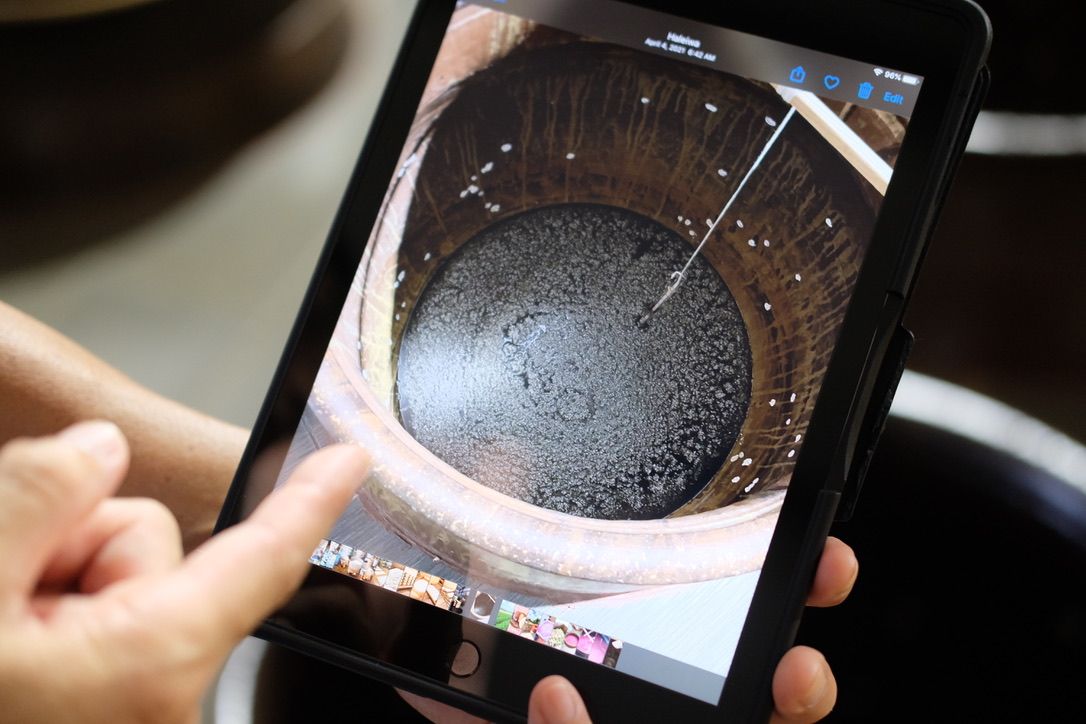
Leafbox:
What's the temperature in there right now?
Ken-san:
86 to 90, depending on the stage.
Leafbox:
Got it.
Ken-san:
Yeah, so we use those vents, one, two, three, four in the walls, on the ceiling, just to control. Yeah, we use fingers, if it's too chilly, I only put one finger wide, and two finger wide, and that's how it is. And after we massage well, I divide that rice into these trays in the back, and I come in here every three, four hours, and do all kinds of stuff, like change the way I stack up these trays. Sometimes I change the shape of the rice inside.
Leafbox:
What does the staging do of the koji?
Ken-san:
Just in order to achieve rapid and even kōji growth, yeah.
Leafbox:
And you're doing this every three hours, you say, right?
Ken-san:
Every three, four hours. Yeah, and this is what it looks like when kōji rice is ready after 48 hours. So, it takes two nights, 48 hours, to convert the rice koji?
Leafbox:
Do you smell a vinegary smell?
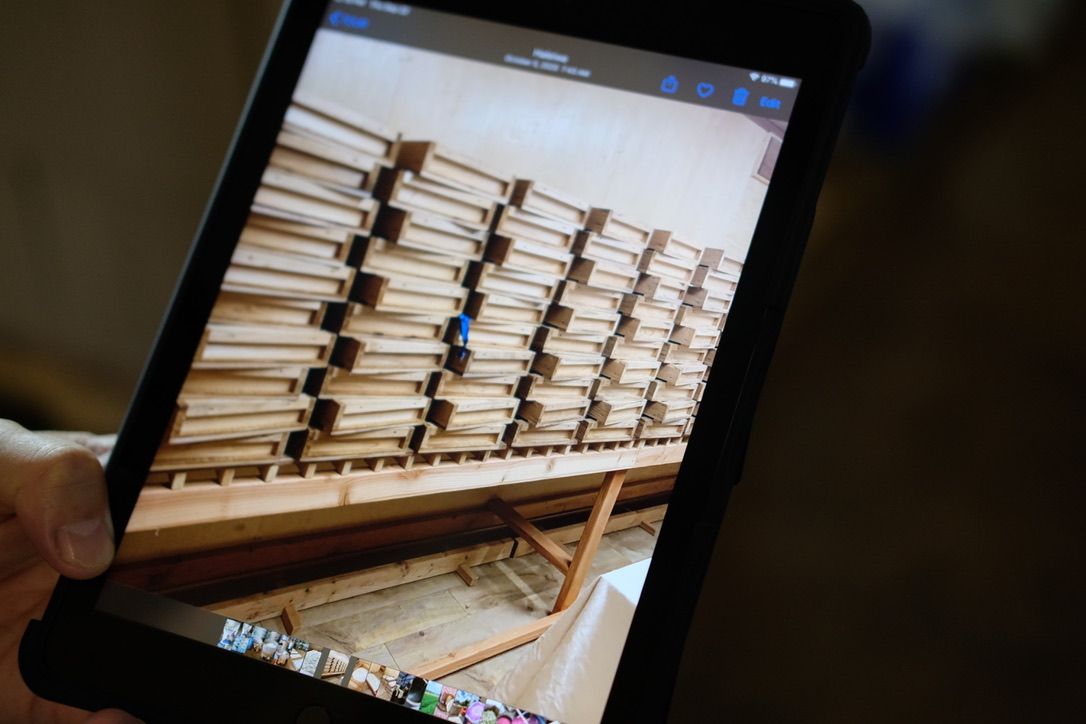
Ken-san:
Not that sour smell, it's more like a sweet smell. It's not that bad.
Leafbox:
Yeah.
Ken-san:
Yeah. Once you smell sour stuff, it's not a good sign, it might be contaminated. Fortunately nothing like that happened so far.
Leafbox:
Do you taste the rice?
Ken-san:
Yeah, it's kind of bitter and sour.
Leafbox:
A little bit.
Ken-san:
Yeah. Bitter and sour, because it produces acid. And these are the vats my master gave us, they all came from Kagoshima, Japan, and they are about 150 years old.
Leafbox:
And you shipped these here?
Ken-san:
Yeah.
Leafbox:
Wow.
Ken-san:
From Kagoshima.
Leafbox:
That must have been very difficult.
Ken-san:
Yeah, we were so happy to see them all, they all came in all intact.
Leafbox:
And then what is around them underneath? Is that dirt?
Ken-san:
Dirt. Yeah, the concrete is only this thick.
Leafbox:
On the top there?
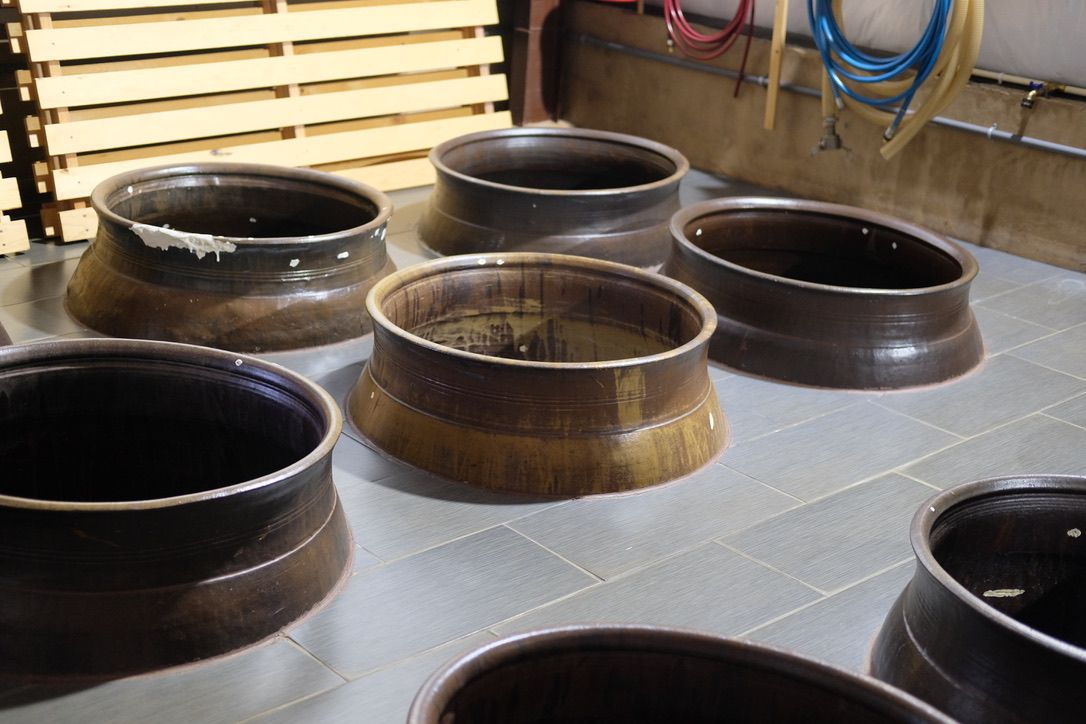
Ken-san:
Yeah, the concrete is only this thick, and then this is all dirt.
Leafbox:
And that helps with the temperature management as well?
Ken-san:
Yeah, that's exactly right, and easy to work out, because it cannot be stood up by itself.
Leafbox:
How do you clean these?
Ken-san:
I put clean shoes and go inside and scrub.
Leafbox:
Got it. Brewing is 90% cleaning.
Ken-san:
Yeah. I'm like a janitor here.
Leafbox:
I know, I understand.
Ken-san:
People think this is a fancy job, but it's not.
Leafbox:
No, it's just cleaning.
Ken-san:
Yeah.
Leafbox:
And it has to be very clean and then clean it again.
Ken-san:
Yeah.
Leafbox:
Yeah.
Ken-san:
I do all the cleaning, so I know what it is.
Leafbox:
Do you use any specialized brewing cleaning?
Ken-san:
Mm-mm.
Leafbox:
Maybe just for the metal tanks, right?
Ken-san:
Yeah, for those, we use those BSG.
Leafbox:
They're citrus based? Yeah.
Ken-san:
Yeah. Until now, this came, so we use that for that, but for others, just the regular...
Leafbox:
Got it. Yeah.
Ken-san:
This is the momori when we take the rice out to this area. And then we put all this into one and add water and the yeast, and let it ferment one week.
Leafbox:
What's the ratio there usually?
Ken-san:
Water and rice?
Leafbox:
Yeah, roughly.
Ken-san:
About one to one. Liters, yeah?
Leafbox:
Yeah, that's fine, so one liter of rice, you put one liter of water.
Ken-san:
One liter of rice... That's a good question.
Leafbox:
For one kilo of rice.
Ken-san:
One kilo per one liter maybe. it depends on the rice.
Leafbox:
When you're steaming the rice, do you wash the rice several times?
Ken-san:
Yeah, I have to wash the rice nice and clean before we steam the rice.
Leafbox:
Do you use the starch water for anything or just throw it in the plants, or?
Ken-san:
Just clean water.
Leafbox:
No, I mean when you wash the rice, do you use that? Put it to the plants or something?
Ken-san:
Yeah.
Leafbox:
Do you filter the water?
Ken-san:
Yeah, we use filtered water as well.
Leafbox:
Nice. Yeah, you don't want the flavor profile from the water.
Ken-san:
So, this is what it looks like after one week.
Leafbox:
Wild.
Ken-san:
Black kōji makes it look dark, yeah? With white kōji it would make it white. This stage, about 10% alcohol, the taste is like unrefined sake, because only kōji rice is brewed. So, while we are waiting, we prepare sweet potatoes. So, this is the farm, this is us, I don't do farming though.
Leafbox:
Yeah, of course.
Ken-san:
Yeah, too much, I might die if we had to. Luckily enough we get to work with the local suppliers, growers. And as I said, many varieties of sweet potatoes in Hawaii. So, each batch is slightly different. For this batch, the pallet came from Moloka‘i.
Leafbox:
Yeah, beautiful.
Ken-san:
The sweet potato came from the big island. So, this batch we blended two varieties. And then we used lots of purple, Okinawa sweet potatoes. For 200 pounds of rice we use about 1,000 pounds of sweet potatoes, after we clean and, we steam. After we steam...
Leafbox:
Where's your steamer?
Ken-san:
Outside.
Leafbox:
Okay, got it.
Ken-san:
After we steam, we put all the steamed sweet potatoes and add this fermented kōji rice to them and mix together. At that time we use these sticks to make it mash.
Leafbox:
Got it, so that's where you're making the mash?
Ken-san:
Yeah.
Leafbox:
That's why you were talking about the industrial process, you're still doing it by hand, before you could pump it and...
Ken-san:
Yeah.
Leafbox:
But this is fine, for the scale, yeah. Beautiful. So, this is the-
Ken-san:
The mash.
Leafbox:
And that's called the moromi?
Ken-san:
Moromi.
Leafbox:
Moromi.
Ken-san:
First moromi. We call this first moromi.
Leafbox:
First one, and the second.
Ken-san:
Second moromi.
Leafbox:
Yeah, the color is so beautiful.
Ken-san:
Yeah, with purple ones, nice color. And then we let this mash ferment. I have a video somewhere. That's how it's fermented, it gets really up to.
Leafbox:
That's amazing.
Ken-san:
Yeah, and then this time, the temperature was going up, so I was chilling with the coil, you see?
Leafbox:
Yeah, that's just with the water, so you don't use any glycol systems or anything?
Ken-san:
No, just run the tap water to chill. Maybe two nights at most. And then we use these wooden pot still.
Leafbox:
So, you pump it?
Ken-san:
Yeah. To here. And it's distilled.
Leafbox:
Yeah.
Ken-san:
And then shochu comes out from here.
Leafbox:
Got it.
Ken-san:
And another thing is we distill only one time.
Leafbox:
Why do you put it in these, instead of... You just pump in and then pump it into this as well?
Ken-san:
Yeah, and because I have to check the scale.
Leafbox:
Alcohol level?
Ken-san:
Check the alcohol level and the condition first before we pump it to the bigger tank.
Leafbox:
And then when do you add the water?
Ken-san:
Before the bottling session.
Leafbox:
And you do flavors and try to adjust?
Ken-san:
Yeah, no flavoring, nothing.
Leafbox:
No, I mean not flavoring but you're tasting to get to the right...
Ken-san:
Yeah. And usually we collect around 38 to 39 or 40, and put it here.
Leafbox:
What are the tools for measuring the alcohol you're using?
Ken-san:
Just a hydrometer.
Leafbox:
Hydrometer. What do they use in Japan, the same?
Ken-san:
The same, but these days, guys use high tech wands.
Leafbox:
Digital or something.
Ken-san:
Like Kō Hana guys, they have really nice machines.
Leafbox:
Got it. I was just curious what traditional techniques they had to measure alcohol.
Ken-san:
Hydrometer, yeah, I think. As long as I know, yeah.
Leafbox:
Got it.
Ken-san:
Yeah, that's it.
Leafbox:
And then bottling?
Ken-san:
Right here. We just finished bottling.
Leafbox:
Got it.
Ken-san:
So, this one is empty, so we're going to start making again next month.
Leafbox:
Nice. Great. What is this kanji here?
Ken-san:
That's our brand name, Namihana.
Leafbox:
Namihana.
Ken-san:
Nami means wave, hana means flower.
Leafbox:
Flower. Wave Flower, yeah. And how did you come up with the name?
Ken-san:
That's a good question. Yeah, we thought about the names, but Hawaii local people told us to name Japanese names, a Japanese name, and the symbol of the North shore is Nami, and Hawaii has lots of beautiful flowers. So, two symbols of Hawaii.
Leafbox:
It's a good name, Namihana. Who drew the kanji? Did you?
Ken-san:
That's a good friend of my master, he's a famous potter, he donated his calligraphy when my master told him that I'm doing this. So, we used that for our label.
Leafbox:
Great.
Ken-san:
Yeah.
Leafbox:
Anything else, Ken, you want to add?
Ken-san:
No, you can be creative.
Leafbox:
No, I think you have a beautiful little operation. Our brewery is a bigger operation, but same process. We never distill though, the licensing requirements for distillation are just so complicated. Maybe Hawaii is easier than other states.
Ken-san:
I'm not sure, because I don't know anything about how it works on the other...
Leafbox:
It's the same, it's the TTB, they're the licensing, I just find it, maybe in Japan easier…
Ken-san:
Japan is hard.
Leafbox:
The licensing also?
Ken-san:
Licensing is horrible.
Leafbox:
Why is that?
Ken-san:
I don't know, the government try to control alcohol productions, they limit it. Yeah, so it's hard to get a new license, so you have to either buy from the existing breweries or distilleries quitting, or you have to work in a special area.
Leafbox:
Nice.
Ken-san:
Yeah because within Kagoshima Prefecture you can find over 100 distilleries, Shochu distilleries. Kagoshima is like Hawaii, that's how much they like to drink.
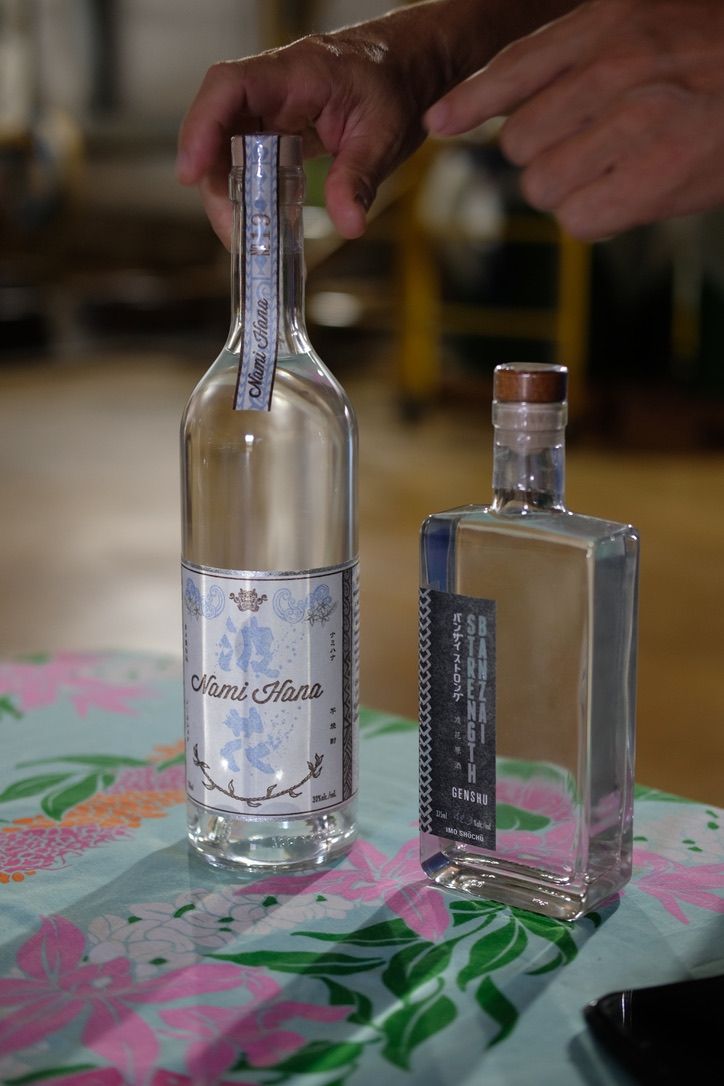
Leafbox:
Rural people, yeah. Japanese people drink a lot actually, surprisingly.
Ken-san:
Yeah.
Leafbox:
Great.
Ken-san:
Lots of beer and sake.
Leafbox:
Anyway, Ken, thank you so much. Sorry for all my questions, this may be... Yeah.
Ken-san:
I'm not used to being asked that much questions, so I hope I was able to answer.
Leafbox:
No, perfect, yeah, there's no right or wrong, just interesting to learn, so.
Thanks to the Hawaiian SHOCHU Company for hosting.
Support local quality producers.
More info:
www.facebook.com/hawaiianshochucompany (English/英語)
www.instagram.com/hawaiianshochucompany (English/英語)
kaloimo.exblog.jp (Japanese/日本語)
